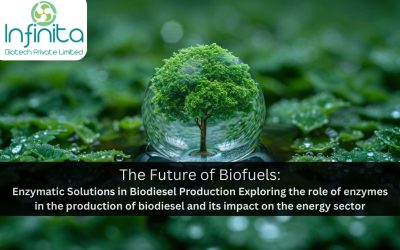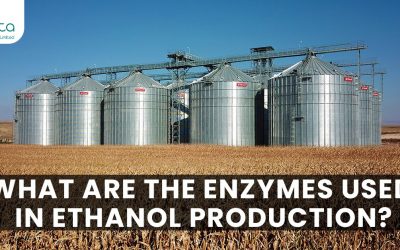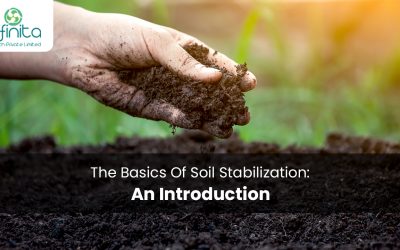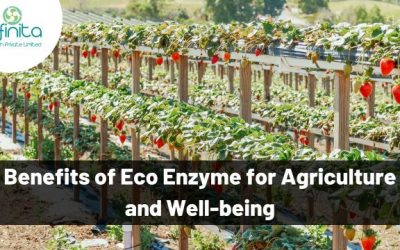
What Is Ethanol And How Is It Made?
Enzymes Used For Ethanol Production
Currently, most ethanol intended for industrial use is produced from ethylene, a petroleum product. Beverage ethanol is produced by fermentation of starch and sugar-rich feed-stacks. Use of cellulose will provide a renewable feedstock for industrial ethanol yet will not compete with the supply of food. Cellulose may be converted to ethanol in two discrete steps. The cellulose is hydrolysed to glucose, which is fermented to ethanol. Fermentation technology has been in development for years by the beverage industry.
Cellulose may be hydrolysed to glucose chemically with acid or enzymatically. Acid hydrolysis processes have the disadvantage that they require severe conditions of high temperature and low pH level. Such conditions make it necessary to employ expensive corrosive-resistant equipment. Conversion efficiency is limited due to glucose degradation. Enzymatic processes have been severely hampered by the high costs associated with enzyme production, the limited accessibility of the substrate to the enzyme, and slow reaction rates. However, enzymatic processes are performed at less severe reaction conditions and have the potential, due to the high specificity of enzymatic reactions, for total conversion of cellulose to glucose. Many flowsheets for the enzymatic cellulose-to-ethanol process have been proposed and all fit into one of three categories: (a) separate hydrolysis, fermentation, and enzyme production steps; (b) simultaneous saccharification and fermentation (SSF), which combines the hydrolysis and fermentation reactions into one step; and (c) direct microbial conversion, which combines all three steps of enzyme production, hydrolysis, and fermentation. In this article let’s talk about Ethanol Production!
1. Feedstock Characteristics
Cellulose does not occur in nature in a pure form. It is always found associated with other materials necessary for biomass structure and growth. Typical compositions of corn stover and aspen wood are shown in the table. Aspen wood has a higher water content than field-dried corn stover (50 wt% and 30.7 wt%t respectively). On a dry basis, aspen wood has a higher cellulose content than corn stover. For the example of a table, the cellulose contents are 38 wt % for corn stover and 49 wt% for aspen wood. The dry basis lignin content of the aspen wood (17 wt%) is higher than that of the corn stover (10 wt%), but both exhibit similar dry-basis hemicellulose contents. The ash content of corn stover is significantly higher than that of aspen wood.
2. Biochemical Processes
-
Biodiesel:
For biodiesel, the enzymes lipase and phospholipase are the major players. A few companies are commercialising biodiesel produced with enzymatic processes. Lipase converts the free fatty acids (FFA) and triacylglycerol to fatty acid methyl esters—the main product comprising biodiesel. The phospholipase is responsible for converting phospholipids to diacyl-glycerol, which becomes a substrate for the lipase. Conventional processes using methanol and catalysts must remove the FFAs and the phospholipids prior to reactions to improve the quality of the biodiesel. Because the enzymes can utilise these as substrates, the yield is higher and the process saves chemical waste. Enzymes are known and available but the cost is often too high for them to be used on all feedstocks, particularly clean plant oils. One way of extending the life and thus lowering the cost of the enzymes is to immobilise them on a solid substrate to enable multiple cycles of use. Another solution is to produce them in a more cost-efficient system or to improve their activity.
-
Cellulosic Ethanol:
For biomass conversion, cellulases are key for the digestion of cellulose into glucose for fermentation into biofuels. Over the past 10 years, intense investigations of issues surrounding the utilisation of cellulosic feedstock for biofuel production have been conducted. Although in theory, this process can utilise the tons of biomass available from farming and dedicated feedstocks, major problems of conversion are encountered. One is the cost of the enzymes needed for the deconstruction of the cellulose and hemicellulose into usable sugar streams. Several approaches have been pursued by researchers including changing the structure of the cell walls to lower the difficulty of digestion, finding better enzymes, using combined digestion and fermentation, and finding better pretreatment technologies to prepare the feedstock for the enzymes.
-
Enzyme Cost:
Pretreated biomass is deconstructed with mixtures of enzymes. To use enzymes cost-effectively, the estimated cost of the enzymes should be $0.10 per gallon of biofuel (NREL estimate). For the past 15 years, intense research on enzyme production platforms has yielded fungal enzyme mixtures that do not meet these cost requirements and in fact, also require a huge infrastructure for production. A relatively new technology utilises genetically engineered plant seeds (primarily maize) to accumulate industrial enzymes. At scale, enzymes from this system can be less expensive to produce and formulate because of low requirements for capital infrastructure. Although the plant seed production system is more cost-competitive, it has not been tested at scale for efficacy. Other research efforts are in multifunctional enzymes and combined bioprocessing organisms, the latter of which can decompose plant polymers as well as ferment them into biofuels.
3. Chemical Catalysts
Chemical catalysis has been the method of choice for the efficient production of transportation fuels from fossil carbon sources so it is natural that it is a mainstay of biomass conversion technology. Many of the routes to biomass transformation involve several steps including depolymerization followed by separation and upgrading processes.
-
Pre-treatment And Deconstruction:
Often the first step is a destructive pretreatment of biomass with a strong acid and base hydrolysis. Recently, researchers have been developing an ammonia-based AFEX™ method. The ammonia treatment separates carbohydrates from lignin and opens up the structure. The method greatly improves the efficiency of enzymatic upgrading. It is likely that other downstream catalytic approaches will also be facilitated by pretreatment.
-
Multifunctional Catalysts:
The products from depolymerisation include highly oxygenated compounds and light gases that are unsuitable for use as fuels. These materials need to be upgraded by separate processes. However, the required separations and waste products from pre-treatment steps increase the complexity and the cost of biofuel production. These requirements have led researchers to search for heterogeneous catalysts that can directly convert biomass into liquid fuels.
Combining biomass depolymerisation and upgrading to liquids by deoxygenation in a single step is particularly attractive. Reforming light gases into liquid products is also desirable. An additional catalyst function is controlling the reactivity of intermediate products to prevent recombination into tar and high molecular weight molecules. The direct conversion requires a method for contacting the biomass with the catalyst either by the use of solvent or volatilisation by pyrolysis.
Multifunctional catalyst systems that combine acid and metals are required to perform all of these tasks. It is difficult to balance the active components of these systems to produce the optimum results. Higher temperatures promote gasification to low-value carbon oxides and acids, which require additional process steps to reform them to liquid fuels. Long contact times can allow recombination reactions. The most common approach to this problem is to perform reactions in different zones without interstage separation. Catalysts which promote conversion at low temperature are highly desirable.
-
Zeolite Catalysts:
Zeolite catalysts have revolutionised petroleum processing so it is not surprising they have received a lot of attention as potential biomass catalysts. ZSM-5 has proved to be the best of the commercial zeolites because of its deoxygenation activity, selectivity to lower molecular weight aromatics, and low coking properties. Recently attention has turned to the effects of adding lower-cost base metals to the zeolite to improve conversion and aromatic selectivity. Ni catalysts have received particular attention. A recent example is adding Ni to ZSM-5 to increase the yield of aromatic hydrocarbons while simultaneously increasing the conversion of oxygenates.
The effect of loading Zr, Co and Fe modified ZSM-5 as a catalyst for treating the vapor phase from the pyrolysis of sawdust is being investigated. The effects of biomass pretreatments were also explored. It was found that the combined pretreatments and use of a Fe-ZSM-5 greatly improved aromatic yields compared to the reaction with unmodified saw dust and ZSM-5.
Zeolite catalysts have some disadvantages in terms of limited hydrothermal stability and a propensity for the microspores to plug with coke or other deposits. Other solid catalysts are being investigated. Direct hydrodeoxygenation of raw woods into liquid alkanes with mass yields up to 28.1 wt% over a multifunctional Pt/NbOPO4 catalyst has been reported. These yields are particularly impressive because the theoretical yield after accounting for the oxygen loss is 50%. However, the use of precious metals may price this approach out of the market. Only slightly lower yields have been achieved using a commercial NiMo hydrotreating catalyst in a pressurised bubbling fluidised bed at high temperature (375-450oC).
Developing a process based on this type of metal on solid acid would require high-pressure systems. Even lower cost metals, like Ni or Mo, would significantly increase catalyst costs. A catalyst transport and regeneration method will likely be necessary.
4. Protection
Safety of Enzymes Used in the Manufacturing of Ethanol from Grains with Use of Co-Products as Animal Feed
Over the past few years, fuel ethanol production from grains has become a major business of national importance, resulting in increased availability of distillers’ grains (DG) for use in animal feed. A natural question is whether the processing aids used in ethanol manufacture are safe for the animals fed the DG co-product. This issue is discussed below for enzymes, which are used as processing aids in biofuels manufacture to maximise the generation of sugars that serve as a substrate for fermentation to ethanol.
Enzymes used as processing aids in ethanol manufacture are nutritionally inconsequential and present little to no safety concern for either animal consuming DG or humans consuming animal products as:
- Enzymes have a long history of safe use in food and animal feed
- Extensive safety data on food and feed enzymes has been collected as part of enzyme GRAS determinations and feed enzyme approvals
- Enzymes are used at very low levels in ethanol manufacture
- Enzymes are inactivated and denatured in the process and any residual enzyme protein is not of any significance in the distillers’ grains
Enzyme preparations used for biofuels manufacture are similar to those used in the production of various foods including bread and beverages. One could ask whether the safety status of enzymes used in fuel ethanol production would be any different from that of enzymes used in near-identical processes for the production of food products such as beer or alcoholic beverages. During the alcohol recovery process which includes distillation at elevated temperatures, the enzymes are completely inactivated and denatured; becoming part of the protein fraction of the by-product, distillers’ grains. Because enzymes are potent catalysts, very small amounts are needed in the process and typically less than 100 ppm is used. Consequently, a very little enzyme derived protein is present in the distillers’ grains.
Based on over 40 years of safe commercial use in food and animal feed, enzymes can be categorised as ‘non-toxic’ and ‘intrinsically safe’ proteins. A large number of safety studies performed as part of numerous regulatory approvals of food enzymes around the world substantiate that enzymes are not mutagenic or clastogenic nor are they oral, reproductive or developmental toxins.
Like enzymes used in food processing and animal feed, enzymes used in biofuels manufacture are produced in well-controlled, submerged fermentations by well-characterised non-pathogenic and non-toxigenic bacteria and fungi. The enzyme production organisms generally have a well-established history of safe use and/or have undergone extensive safety evaluations as part of GRAS determinations prior to being employed for the production of food and feed enzymes 4,5. The fermentation media components are of the appropriate purity for the intended use of the enzyme. A typical enzyme preparation contains the enzyme protein (e.g., glucoamylase, protease, etc.), non-enzyme components from the fermentation (peptides, amino acids, carbohydrates, lipids, salts), and formulation ingredients to standardise and maintain activity and/or improve handling. The formulation ingredients are carefully selected and established to be safe for the intended use. Enzyme preparations do not contain viable production microorganisms. By-products from other fermentation processes to manufacture certain pharmaceutical and food ingredients have been fed to livestock for several decades without incident. These fermentation by-products, like distillers’ grains, contain the remnants of the production microorganism, enzymes and spent biomass from the process.
Due to the catalytic nature of enzymes, they are used at very low levels in the ethanol process, typically in the range of 25 to 100 ppm active enzyme. During the ethanol, process enzymes are denatured by high temperature and/or low pH during liquefaction and saccharification, and high temperature and lack of substrate during distillation, evaporation of syrup, and drying of DG. Further, the extent to which Distillers Grains are included in animal feed rations is self-limiting due to their incomplete nutrient profile. The maximum practical inclusion rate of DG in animal feed is 50%, as diets with more than 50% distiller’s grains from any source would result in suboptimal animal performance and growers’ profitability6,7. All of these factors result in very low exposure of enzyme protein to the animals. When all these facts are taken into consideration, it is evident that enzymes used for biofuels manufacture and the resultant distillers’ grains do not present any risks to livestock or the human food chain. Therefore, enzymes for biofuels production are safe for their intended use.
CELLULASE COMPLEX ENZYMES
Our specialised cellulase complex enzymes formulation can be utilised for producing fermentable sugars from cellulosic material.

Multi Enzymes
Complex

Applicable To
Various Feedstocks

Accelerates SSF
Process
LIPASE COMPLEX ENZYMES
Our specialised Lipase Complex Enzymes for esterification of edible and non – edible Oils can be utilised to produce biodiesel.

Eco-Friendly

Efficient
Esterification

Highly Specific
Lipase
Related Articles
The Future of Biofuels: Enzymatic Solutions in Biodiesel Production Exploring the role of enzymes in the production of biodiesel and its impact on the energy sector.
Biofuels have emerged as a promising solution to combat climate change and reduce our dependence on fossil fuels. With advancements in technology, enzymatic solutions are revolutionizing the production of biodiesel, offering a more efficient and sustainable...
What Are The Enzymes Used In Ethanol Production?
Given the predicted exhaustion of Crude-oil-based fuel energy supply, bioethanol has gained importance as an alternate source of energy. Bioethanol is produced via microbial fermentation and offers a cost-effective source of energy. Microbes produce the majority of...

What Is Ethanol And How Is It Made?
Enzymes Used For Ethanol Production
Currently, most ethanol intended for industrial use is produced from ethylene, a petroleum product. Beverage ethanol is produced by fermentation of starch and sugar-rich feed-stacks. Use of cellulose will provide a renewable feedstock for industrial ethanol yet will not compete with the supply of food. Cellulose may be converted to ethanol in two discrete steps. The cellulose is hydrolysed to glucose, which is fermented to ethanol. Fermentation technology has been in development for years by the beverage industry.
Cellulose may be hydrolysed to glucose chemically with acid or enzymatically. Acid hydrolysis processes have the disadvantage that they require severe conditions of high temperature and low pH level. Such conditions make it necessary to employ expensive corrosive-resistant equipment. Conversion efficiency is limited due to glucose degradation. Enzymatic processes have been severely hampered by the high costs associated with enzyme production, the limited accessibility of the substrate to the enzyme, and slow reaction rates. However, enzymatic processes are performed at less severe reaction conditions and have the potential, due to the high specificity of enzymatic reactions, for total conversion of cellulose to glucose. Many flowsheets for the enzymatic cellulose-to-ethanol process have been proposed and all fit into one of three categories: (a) separate hydrolysis, fermentation, and enzyme production steps; (b) simultaneous saccharification and fermentation (SSF), which combines the hydrolysis and fermentation reactions into one step; and (c) direct microbial conversion, which combines all three steps of enzyme production, hydrolysis, and fermentation. In this article let’s talk about Ethanol Production!
1. Feedstock Characteristics
Cellulose does not occur in nature in a pure form. It is always found associated with other materials necessary for biomass structure and growth. Typical compositions of corn stover and aspen wood are shown in the table. Aspen wood has a higher water content than field-dried corn stover (50 wt% and 30.7 wt%t respectively). On a dry basis, aspen wood has a higher cellulose content than corn stover. For the example of a table, the cellulose contents are 38 wt % for corn stover and 49 wt% for aspen wood. The dry basis lignin content of the aspen wood (17 wt%) is higher than that of the corn stover (10 wt%), but both exhibit similar dry-basis hemicellulose contents. The ash content of corn stover is significantly higher than that of aspen wood.
2. Biochemical Processes
-
Biodiesel:
For biodiesel, the enzymes lipase and phospholipase are the major players. A few companies are commercialising biodiesel produced with enzymatic processes. Lipase converts the free fatty acids (FFA) and triacylglycerol to fatty acid methyl esters—the main product comprising biodiesel. The phospholipase is responsible for converting phospholipids to diacyl-glycerol, which becomes a substrate for the lipase. Conventional processes using methanol and catalysts must remove the FFAs and the phospholipids prior to reactions to improve the quality of the biodiesel. Because the enzymes can utilise these as substrates, the yield is higher and the process saves chemical waste. Enzymes are known and available but the cost is often too high for them to be used on all feedstocks, particularly clean plant oils. One way of extending the life and thus lowering the cost of the enzymes is to immobilise them on a solid substrate to enable multiple cycles of use. Another solution is to produce them in a more cost-efficient system or to improve their activity.
-
Cellulosic Ethanol:
For biomass conversion, cellulases are key for the digestion of cellulose into glucose for fermentation into biofuels. Over the past 10 years, intense investigations of issues surrounding the utilisation of cellulosic feedstock for biofuel production have been conducted. Although in theory, this process can utilise the tons of biomass available from farming and dedicated feedstocks, major problems of conversion are encountered. One is the cost of the enzymes needed for the deconstruction of the cellulose and hemicellulose into usable sugar streams. Several approaches have been pursued by researchers including changing the structure of the cell walls to lower the difficulty of digestion, finding better enzymes, using combined digestion and fermentation, and finding better pretreatment technologies to prepare the feedstock for the enzymes.
-
Enzyme Cost:
Pretreated biomass is deconstructed with mixtures of enzymes. To use enzymes cost-effectively, the estimated cost of the enzymes should be $0.10 per gallon of biofuel (NREL estimate). For the past 15 years, intense research on enzyme production platforms has yielded fungal enzyme mixtures that do not meet these cost requirements and in fact, also require a huge infrastructure for production. A relatively new technology utilises genetically engineered plant seeds (primarily maize) to accumulate industrial enzymes. At scale, enzymes from this system can be less expensive to produce and formulate because of low requirements for capital infrastructure. Although the plant seed production system is more cost-competitive, it has not been tested at scale for efficacy. Other research efforts are in multifunctional enzymes and combined bioprocessing organisms, the latter of which can decompose plant polymers as well as ferment them into biofuels.
3. Chemical Catalysts
Chemical catalysis has been the method of choice for the efficient production of transportation fuels from fossil carbon sources so it is natural that it is a mainstay of biomass conversion technology. Many of the routes to biomass transformation involve several steps including depolymerization followed by separation and upgrading processes.
-
Pre-treatment And Deconstruction:
Often the first step is a destructive pretreatment of biomass with a strong acid and base hydrolysis. Recently, researchers have been developing an ammonia-based AFEX™ method. The ammonia treatment separates carbohydrates from lignin and opens up the structure. The method greatly improves the efficiency of enzymatic upgrading. It is likely that other downstream catalytic approaches will also be facilitated by pretreatment.
-
Multifunctional Catalysts:
The products from depolymerisation include highly oxygenated compounds and light gases that are unsuitable for use as fuels. These materials need to be upgraded by separate processes. However, the required separations and waste products from pre-treatment steps increase the complexity and the cost of biofuel production. These requirements have led researchers to search for heterogeneous catalysts that can directly convert biomass into liquid fuels.
Combining biomass depolymerisation and upgrading to liquids by deoxygenation in a single step is particularly attractive. Reforming light gases into liquid products is also desirable. An additional catalyst function is controlling the reactivity of intermediate products to prevent recombination into tar and high molecular weight molecules. The direct conversion requires a method for contacting the biomass with the catalyst either by the use of solvent or volatilisation by pyrolysis.
Multifunctional catalyst systems that combine acid and metals are required to perform all of these tasks. It is difficult to balance the active components of these systems to produce the optimum results. Higher temperatures promote gasification to low-value carbon oxides and acids, which require additional process steps to reform them to liquid fuels. Long contact times can allow recombination reactions. The most common approach to this problem is to perform reactions in different zones without interstage separation. Catalysts which promote conversion at low temperature are highly desirable.
-
Zeolite Catalysts:
Zeolite catalysts have revolutionised petroleum processing so it is not surprising they have received a lot of attention as potential biomass catalysts. ZSM-5 has proved to be the best of the commercial zeolites because of its deoxygenation activity, selectivity to lower molecular weight aromatics, and low coking properties. Recently attention has turned to the effects of adding lower-cost base metals to the zeolite to improve conversion and aromatic selectivity. Ni catalysts have received particular attention. A recent example is adding Ni to ZSM-5 to increase the yield of aromatic hydrocarbons while simultaneously increasing the conversion of oxygenates.
The effect of loading Zr, Co and Fe modified ZSM-5 as a catalyst for treating the vapor phase from the pyrolysis of sawdust is being investigated. The effects of biomass pretreatments were also explored. It was found that the combined pretreatments and use of a Fe-ZSM-5 greatly improved aromatic yields compared to the reaction with unmodified saw dust and ZSM-5.
Zeolite catalysts have some disadvantages in terms of limited hydrothermal stability and a propensity for the microspores to plug with coke or other deposits. Other solid catalysts are being investigated. Direct hydrodeoxygenation of raw woods into liquid alkanes with mass yields up to 28.1 wt% over a multifunctional Pt/NbOPO4 catalyst has been reported. These yields are particularly impressive because the theoretical yield after accounting for the oxygen loss is 50%. However, the use of precious metals may price this approach out of the market. Only slightly lower yields have been achieved using a commercial NiMo hydrotreating catalyst in a pressurised bubbling fluidised bed at high temperature (375-450oC).
Developing a process based on this type of metal on solid acid would require high-pressure systems. Even lower cost metals, like Ni or Mo, would significantly increase catalyst costs. A catalyst transport and regeneration method will likely be necessary.
4. Protection
Safety of Enzymes Used in the Manufacturing of Ethanol from Grains with Use of Co-Products as Animal Feed
Over the past few years, fuel ethanol production from grains has become a major business of national importance, resulting in increased availability of distillers’ grains (DG) for use in animal feed. A natural question is whether the processing aids used in ethanol manufacture are safe for the animals fed the DG co-product. This issue is discussed below for enzymes, which are used as processing aids in biofuels manufacture to maximise the generation of sugars that serve as a substrate for fermentation to ethanol.
Enzymes used as processing aids in ethanol manufacture are nutritionally inconsequential and present little to no safety concern for either animal consuming DG or humans consuming animal products as:
- Enzymes have a long history of safe use in food and animal feed
- Extensive safety data on food and feed enzymes has been collected as part of enzyme GRAS determinations and feed enzyme approvals
- Enzymes are used at very low levels in ethanol manufacture
- Enzymes are inactivated and denatured in the process and any residual enzyme protein is not of any significance in the distillers’ grains
Enzyme preparations used for biofuels manufacture are similar to those used in the production of various foods including bread and beverages. One could ask whether the safety status of enzymes used in fuel ethanol production would be any different from that of enzymes used in near-identical processes for the production of food products such as beer or alcoholic beverages. During the alcohol recovery process which includes distillation at elevated temperatures, the enzymes are completely inactivated and denatured; becoming part of the protein fraction of the by-product, distillers’ grains. Because enzymes are potent catalysts, very small amounts are needed in the process and typically less than 100 ppm is used. Consequently, a very little enzyme derived protein is present in the distillers’ grains.
Based on over 40 years of safe commercial use in food and animal feed, enzymes can be categorised as ‘non-toxic’ and ‘intrinsically safe’ proteins. A large number of safety studies performed as part of numerous regulatory approvals of food enzymes around the world substantiate that enzymes are not mutagenic or clastogenic nor are they oral, reproductive or developmental toxins.
Like enzymes used in food processing and animal feed, enzymes used in biofuels manufacture are produced in well-controlled, submerged fermentations by well-characterised non-pathogenic and non-toxigenic bacteria and fungi. The enzyme production organisms generally have a well-established history of safe use and/or have undergone extensive safety evaluations as part of GRAS determinations prior to being employed for the production of food and feed enzymes 4,5. The fermentation media components are of the appropriate purity for the intended use of the enzyme. A typical enzyme preparation contains the enzyme protein (e.g., glucoamylase, protease, etc.), non-enzyme components from the fermentation (peptides, amino acids, carbohydrates, lipids, salts), and formulation ingredients to standardise and maintain activity and/or improve handling. The formulation ingredients are carefully selected and established to be safe for the intended use. Enzyme preparations do not contain viable production microorganisms. By-products from other fermentation processes to manufacture certain pharmaceutical and food ingredients have been fed to livestock for several decades without incident. These fermentation by-products, like distillers’ grains, contain the remnants of the production microorganism, enzymes and spent biomass from the process.
Due to the catalytic nature of enzymes, they are used at very low levels in the ethanol process, typically in the range of 25 to 100 ppm active enzyme. During the ethanol, process enzymes are denatured by high temperature and/or low pH during liquefaction and saccharification, and high temperature and lack of substrate during distillation, evaporation of syrup, and drying of DG. Further, the extent to which Distillers Grains are included in animal feed rations is self-limiting due to their incomplete nutrient profile. The maximum practical inclusion rate of DG in animal feed is 50%, as diets with more than 50% distiller’s grains from any source would result in suboptimal animal performance and growers’ profitability6,7. All of these factors result in very low exposure of enzyme protein to the animals. When all these facts are taken into consideration, it is evident that enzymes used for biofuels manufacture and the resultant distillers’ grains do not present any risks to livestock or the human food chain. Therefore, enzymes for biofuels production are safe for their intended use.
0 Comments
Submit a Comment
You must be logged in to post a comment.
CELLULASE COMPLEX ENZYMES
Our specialised cellulase complex enzymes formulation can be utilised for producing fermentable sugars from cellulosic material.

Multi Enzymes Complex

Applicable To Various Feedstocks

Accelerates SSF Process
LIPASE COMPLEX ENZYMES
Our specialised Lipase Complex Enzymes for esterification of edible and non – edible Oils can be utilised to produce biodiesel.

Eco-Friendly

Efficient Esterification

Highly Specific Lipase
The Basics of Soil Stabilization: An Introduction
What is Soil Stabilization? Definition: Have you ever wondered how builders manage to create rock-solid foundations for structures, even on unstable grounds? That's where soil stabilization becomes critical. At its core, soil stabilization refers to the process of...
Bio Enzyme Uses and Their Applications
Benefits of Eco Enzyme for Agriculture and Well-being
In today's world, where sustainable practices and holistic well-being are gaining prominence, the eco enzyme has emerged as a remarkable solution with numerous benefits for both agriculture and overall well-being. This powerful organic concoction offers a multitude of...






0 Comments